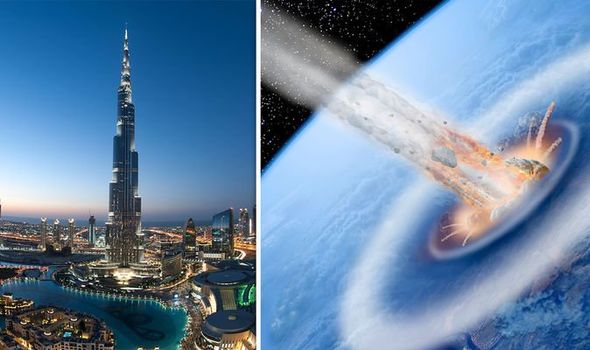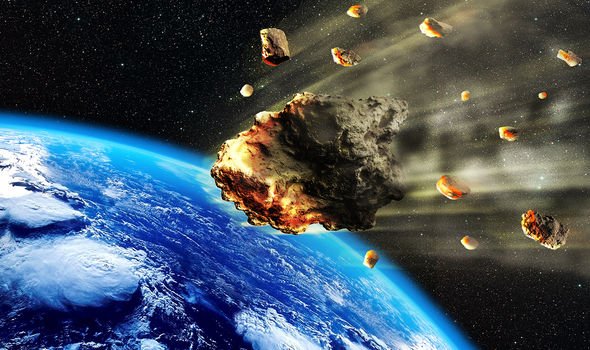Huge ‘potentially hazardous’ asteroid twice the size of the Burj Khalifa to skim past Earth in March

A massive mile wide asteroid twice the size of the tallest building in the world will ‘skim’ past the Earth in March and has been dubbed ‘potentially hazardous’ by NASA.
The asteroid, named 231937 (2001 FO32), is unlikely to hit the Earth as it will be 1.2 million miles from the planet – five times further out than the Moon.
However, NASA dubs any space rock that comes within 93 million miles of us a ‘Near Earth Object’, which is three quarters of the 120 million mile distance to Mars.
The mile wide by half a mile long space rock will make its closest approach to our planet at about 16:03 GMT on March 21, 2021 and has been branded ‘potentially hazardous’ as it ‘might’ hit the planet at some point in the future of the solar system.

Asteroid 231937 is the largest space rock to ‘come close’ to the Earth this year and at 1.7km is more than twice the size of the tallest building on Earth – the Burj Khalifa.
It should be possible to see the asteroid through an eight inch aperture telescope just after sunset on March 21 by looking slightly above the southern horizon.
Asteroid 231937 is the largest space rock to ‘come close’ to the Earth this year and at 1.7km is more than twice the size of the tallest building on Earth – the Burj Khalifa
NASA dubs any space rock that comes within 93 million miles of us a ‘Near Earth Object’, which is three quarters of the 120 million mile distance to Mars
The asteroid was first detected in 2001 by an array of telescopes in New Mexico that are part of the Lincoln Near-Earth Asteroid Research (LINEAR) program.

The MIT project is funded by the US Air Force and NASA and it detected the space rock on March 23, 2001 and has been under observation ever since.
Using those observations astronomers calculated its orbit, found how close it would get to Earth and determined it would be going at 77,000mph.
SpaceReference.org wrote of the asteroid: ‘Based on its brightness and the way it reflects light, 2001 FO32 is probably between 0.767 to 1.714 kilometers in diameter, making it larger than ~97% of asteroids but small compared to large asteroids.’
The asteroid and Earth are seen on the left of this orbital map on the ‘blue’ Earth orbit line – the orbit of the asteroid is visible through the tall white lines
It should be possible to see the asteroid through an eight inch aperture telescope just after sunset on March 21 by looking slightly above the southern horizon. The pink dot is the asteroid and the lighter area is the sky visible from the UK on March 21 after sunset
It may be possible to see the space rock as it hurtles past the planet in March if you have a telescope with an aperture of at least eight inches.
The asteroid will be low in the southern sky, so may be difficult to spot from the norther hemisphere, according to EarthSky.org.
To find it look just above the horizon in the southern sky will glide through the southern constellations of Scorpius and Sagittarius.
It will be visible just above the horizon in the southern sky just after sunset if viewed from the UK and just before dawn if viewed from the southern US.
NASA keeps a close eye on all Near Earth Asteroids to determine whether any could come close to hitting the planet.
A massive mile wide asteroid twice the size of the tallest building in the world – the Burj Khalifa (pictured centre) – will ‘skim’ past the Earth in March
It is a broad definition – covering any object within about 93 million miles of the Earth – those dubbed ‘hazardous’ come within 4.6 million miles and are at least 500ft wide.
There are currently no asteroids that pose a significant risk to life on Earth for at least the next century, according to NASA, with just one having a 0.2 per cent chance of hitting the planet in 2185.
In the meantime space agencies around the world are investigating potential solutions for deflecting a future asteroid from hitting the Earth.
NASA has looked at using gravity from a flying spacecraft to ‘pull an asteroid’ to a new trajectory.
Astronomers are hunting for asteroids larger than 450ft as they can cause ‘catastrophic damage’
Researchers have discovered most of the asteroids that are about a kilometers in size, but are now on the hunt for those that are about 459ft (140m) – as they could cause catastrophic damage.
Although nobody knows when the next big impact will occur, scientists have found themselves under pressure to predict – and intercept – its arrival.
Artist’s impression pictured
‘Sooner or later we will get… a minor or major impact,’ said Rolf Densing, who heads the European Space Operations Centre (ESOC) in Darmstadt
It may not happen in our lifetime, he said, but ‘the risk that Earth will get hit in a devastating event one day is very high.’
‘For now, there is little we can do.’

